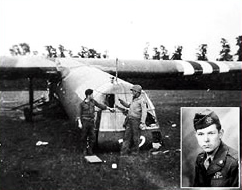3-9 June 1944
Crosses at Normandy
The Normandy Invasion began with a massive bombing raid and naval bombardment along the French coast, followed by an aerial assault by paratroopers of the 82nd and 101st Airborne Divisions just behind enemy lines. One of the many units supporting the 82nd Airborne was the 4th Platoon, 603rd Quartermaster Graves Registration Company.
 Instead of going in a day or two later, as originally planned, one young Graves Registration specialist — Sergeant Elbert Legg — volunteered to cross the English Channel in a British made Horsa glider and join the assault on D-Day, 6 June 1944.
Instead of going in a day or two later, as originally planned, one young Graves Registration specialist — Sergeant Elbert Legg — volunteered to cross the English Channel in a British made Horsa glider and join the assault on D-Day, 6 June 1944.
Eerie silence marked most of their journey, over the water, the coastline, past German defenses, the infamous French hedgerows, to the clearing beyond. His glider (“Number 32”) was cut loose and down she went, crash-landing in an open field.
Discovering he was OK, Sergeant Legg wasted no time setting up a collection point, and immediately began receiving the dead. More bodies followed. Then more. By the end of the first week nearly 350 American soldiers had been buried in the temporary cemetery at Blosville. Nearly 6,000 by the end of June.
Read this article from the History & Heritage section for more information: Crosses at Normandy
Compiled by Dr. Steven Anders, former Quartermaster School historian.
Quote of the Week:
We won the battle of Normandy, [but] considering the high price in American lives, we lost.— Martin Blumenson Breakout and Pursuit (1961)
